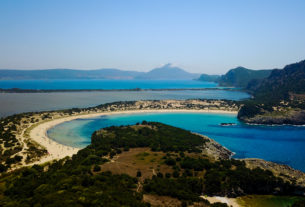We tapped a few of the country’s leading wine experts to give us the lowdown on the most interesting, unusual, and unexpected wine regions.
Here’s a shortlist of destinations not miss in 2019.
Grisons (or Graubünden), Switzerland
This Swiss canton may be best known for its upscale ski resorts, including St. Moritz and Davos (home of the World Economic Forum), but it’s also where some of Switzerland’s finest wines are made—especially in the northern Bündner Herrschaft area. “The pinot noirs and rieslings here are lovely and very terroir driven,” says Jessica Hereth, restaurant and wine director at Olympia Provisions in Portland, Oregon. “They have a herbaceous, floral character and smell like fields of wild flowers and cut grass. Even the reds have almost a potpourri quality.” If you’re going for the wine and not the slopes, the best time to visit is late spring and summer when you’ll be greeted by classic alpine landscapes, bright green valleys, and snow-capped peaks. Don’t miss the husband-and-wife winery of Jann Marugg in the village of Fläsch—it’s nearly impossible to find these wines in the U.S., so make the most of them while you’re there.
Yarra Valley, Australia
Less than an hour’s drive from Melbourne, the mellow hills surrounding the Yarra river conjure one of the most idyllic wine country landscapes in Australia. Although wine’s been made here for more than 180 years, the Yarra Valley is only recently being recognized by sommeliers for its premium bottles and natural winemaking. Elevation and cooler climates—there are cross-country ski resorts on nearby Lake Mountain—create the perfect terroir for beautiful chardonnays and pinot noirs. “These wines have a focused and refreshing acidity,” says Ashley Hausman MW, owner of Mistral Wine Co. in Denver. “They’re restrained in their fruit profiles and never overripe.” Among her favorite wineries are Patrick Sullivan Wines, known for their elegance and minimalism, and Blackwood Hill, makers of excellent natural wines. And when you’re not winery hopping, there’s plenty of hiking and biking to keep you on the go.
The Azores, Portugal
As if dramatic cliffs, lake-filled calderas, and pretty fishing villages weren’t reasons enough to travel to the Azores—an archipelago of nine islands in the middle of the Atlantic—there are also great wines to be sipped, made with obscure indigenous grapes. “Arinto dos Acores is the most compelling [white] grape. While similar in name to mainland Arinto, this is a unique variety,” says Jhonel Faelnar, wine director at Atomix in New York City. What makes it special are the islands’ volcanic soils and proximity to the ocean, which give most Azorean wines “an amazing salinity, along with a freshness and verve on the palate.” While the whites are the stars, the Azores Wine Company also produces a thought-provoking red from the Isabella grape, a Vitis Labrusca variety similar to the Concord grape that’s shunned for fine wine production because of its strong earthy flavors. “This is something that isn’t quite being done elsewhere and is re-defining what fine wine can be,” says Faelnar. The island of Pico is where most Azorean wine grapes are grown, using volcanic rocks to create low barriers that protect the vines from the harsh island winds. The climate is mild year round, but if you go in the summer right before harvest, you can enjoy a little time in the sun between wine tastings.
Savoie, France
The wines of Savoie in the southeast of France near the Italian and Swiss border “smell like the opening scene of The Sound of Music!” says Matt Tunstall, co-owner of Stems and Skins in Charleston. “The whites especially have an alpine-meadow freshness and floral aromas.” Local grapes like Jacquère, Roussette, and Chasselas (all white) and the Mondeuse and Gamay red grapes are grown at the foot of the Alps at significant altitudes, which give the wines—including the reds—a light, aromatic quality. Young, enthusiastic winemakers have infused new energy into the wines of this region—once known mainly as light après-ski drinks—making them food-friendly with strong characters and aging potential. Seek out the Domaine du Cellier Des Cray and be sure to taste their Clemence made with 100 percent Roussette, a lovely wine that’s complex and textured while remaining light. Pack it in your picnic basket along with some the local cheeses during prime season in the spring and summer. Or—why not?—enjoy it après ski if you visit in the winter.
Maule Valley, Chile
There are so many Chilean wine regions, it can be hard to stay focused when planning a trip. Ryan Plas, “The Wine Guy” at Coquette in New Orleans, recommends heading straight to the often overlooked Maule Valley, south of the town of Talca. Here, he says, “I tasted wines made with grapes that seemed to have found their sense of place, particularly old vines of the pais grape.” Pais is a red wine grape that has been grown in Chile for centuries but lost favor to international varieties like cabernet sauvignon and has since been used primarily to make jug wine. Today, producers like Louis-Antoine Luyt are changing that, using dry organic farming (i.e. no irrigation) and the least amount of intervention in the vineyard to make fine wines. “Pais makes some of the most floral and fresh red wines,” says Plas. “They’re typically very light bodied, with a vibrant, fresh acidity and just a touch of preserved red fruit.” Most wineries offer tours year-round, but the best time to go is between November and May. Besides Luyt’s winery, don’t miss Viña González Bastías, which organizes guided tours and tastings.




